2012 SKODA CITIGO seats
[x] Cancel search: seatsPage 45 of 157
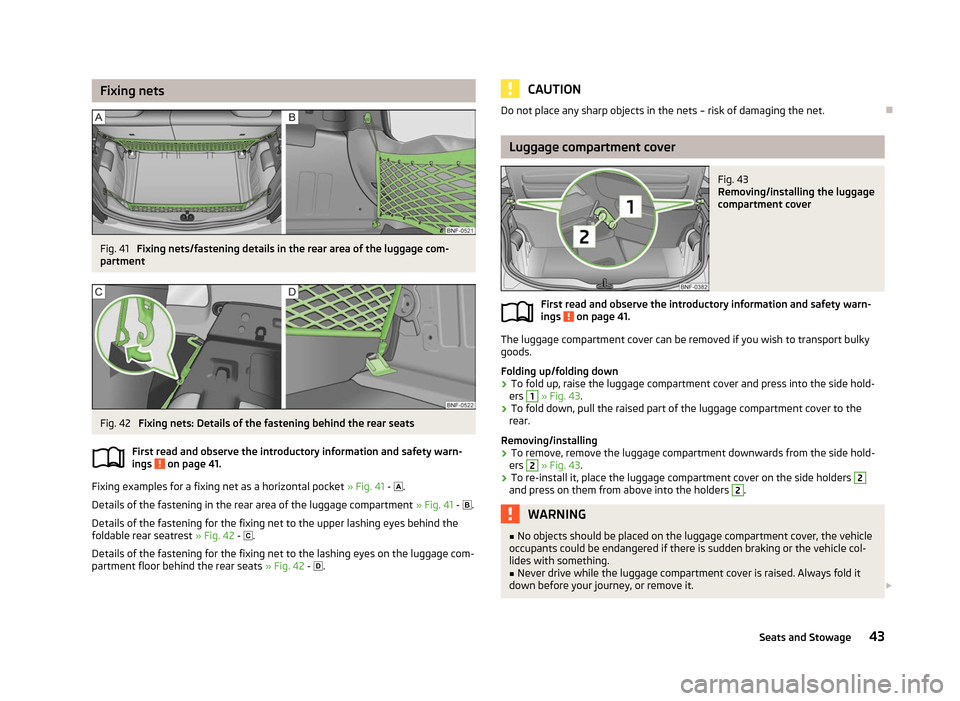
Fixing nets
Fig. 41
Fixing nets/fastening details in the rear area of the luggage com-
partment Fig. 42
Fixing nets: Details of the fastening behind the rear seats
First read and observe the introductory information and safety warn-
ings on page 41.
Fixing examples for a fixing net as a horizontal pocket
» Fig. 41 - .
Details of the fastening in the rear area of the luggage compartment » Fig. 41 - .
Details of the fastening for the fixing net to the upper lashing eyes behind the
foldable rear seatrest » Fig. 42 - .
Details of the fastening for the fixing net to the lashing eyes on the luggage com-
partment floor behind the rear seats » Fig. 42 - .
ä CAUTION
Do not place any sharp objects in the nets – risk of damaging the net. Ð Luggage compartment cover
Fig. 43
Removing/installing the luggage
compartment cover
First read and observe the introductory information and safety warn-
ings on page 41.
The luggage compartment cover can be removed if you wish to transport bulky
goods.
Folding up/folding down
›
To fold up, raise the luggage compartment cover and press into the side hold-
ers 1
» Fig. 43.
› To fold down, pull the raised part of the luggage compartment cover to the
rear.
Removing/installing
› To remove, remove the luggage compartment downwards from the side hold-
ers 2
» Fig. 43.
› To re-install it, place the luggage compartment cover on the side holders 2
and press on them from above into the holders 2
.
WARNING
■ No objects should be placed on the luggage compartment cover, the vehicle
occupants could be endangered if there is sudden braking or the vehicle col-
lides with something.
■ Never drive while the luggage compartment cover is raised. Always fold it
down before your journey, or remove it. £
ä
43
Seats and Stowage
Page 47 of 157
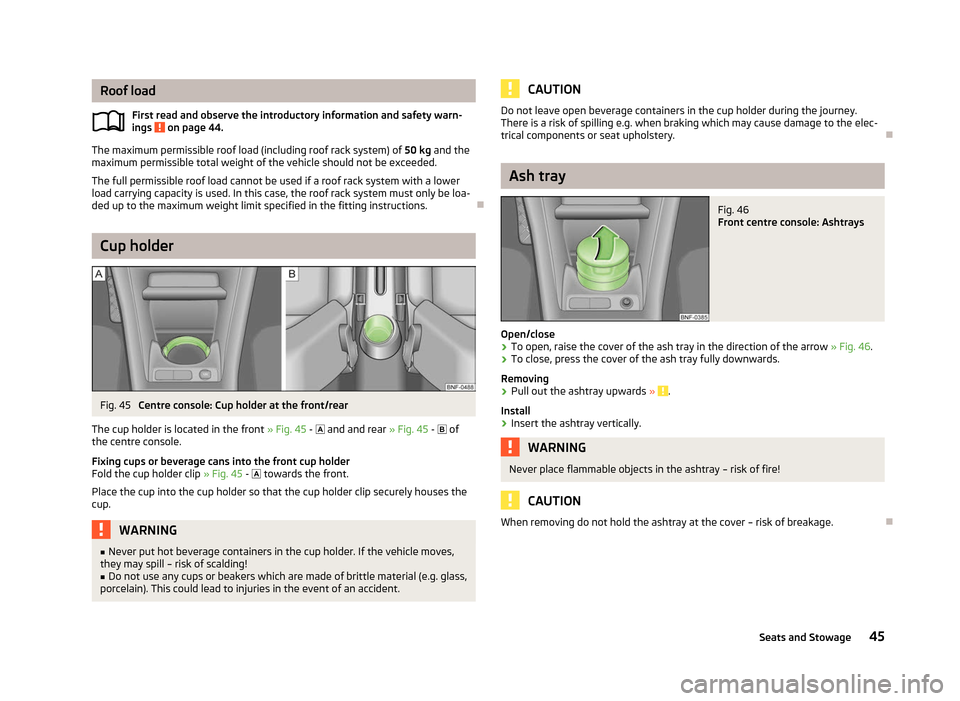
Roof load
First read and observe the introductory information and safety warn-
ings on page 44.
The maximum permissible roof load (including roof rack system) of
50 kg and the
maximum permissible total weight of the vehicle should not be exceeded.
The full permissible roof load cannot be used if a roof rack system with a lower
load carrying capacity is used. In this case, the roof rack system must only be loa-
ded up to the maximum weight limit specified in the fitting instructions. ÐCup holder
Fig. 45
Centre console: Cup holder at the front/rear
The cup holder is located in the front » Fig. 45 - and and rear » Fig. 45 - of
the centre console.
Fixing cups or beverage cans into the front cup holder
Fold the cup holder clip » Fig. 45 - towards the front.
Place the cup into the cup holder so that the cup holder clip securely houses the
cup. WARNING
■ Never put hot beverage containers in the cup holder. If the vehicle moves,
they may spill – risk of scalding! ■ Do not use any cups or beakers which are made of brittle material (e.g. glass,
porcelain). This could lead to injuries in the event of an accident.
ä CAUTION
Do not leave open beverage containers in the cup holder during the journey.
There is a risk of spilling e.g. when braking which may cause damage to the elec-
trical components or seat upholstery. Ð Ash tray
Fig. 46
Front centre console: Ashtrays
Open/close
› To open, raise the cover of the ash tray in the direction of the arrow
» Fig. 46.
› To close, press the cover of the ash tray fully downwards.
Removing
› Pull out the ashtray upwards
» .
Install
› Insert the ashtray vertically. WARNING
Never place flammable objects in the ashtray – risk of fire! CAUTION
When removing do not hold the ashtray at the cover – risk of breakage. Ð
45
Seats and Stowage
Page 49 of 157
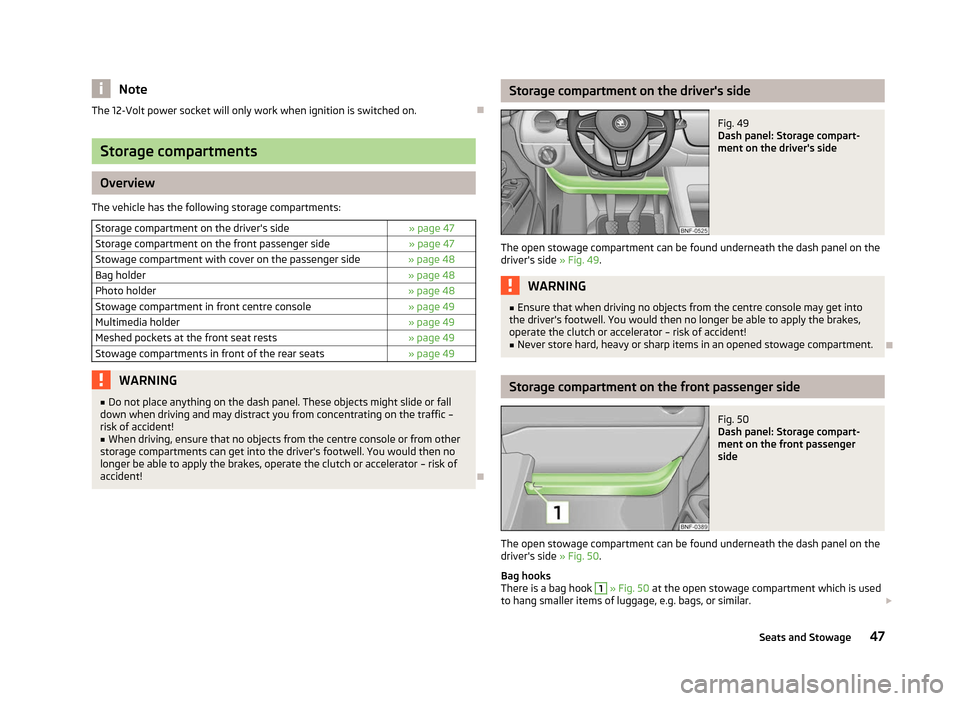
Note
The 12-Volt power socket will only work when ignition is switched on. ÐStorage compartments
Overview
The vehicle has the following storage compartments: Storage compartment on the driver's side » page 47
Storage compartment on the front passenger side » page 47
Stowage compartment with cover on the passenger side » page 48
Bag holder » page 48
Photo holder » page 48
Stowage compartment in front centre console » page 49
Multimedia holder » page 49
Meshed pockets at the front seat rests » page 49
Stowage compartments in front of the rear seats » page 49WARNING
■ Do not place anything on the dash panel. These objects might slide or fall
down when driving and may distract you from concentrating on the traffic –
risk of accident!
■ When driving, ensure that no objects from the centre console or from other
storage compartments can get into the driver's footwell. You would then no
longer be able to apply the brakes, operate the clutch or accelerator – risk of
accident! Ð Storage compartment on the driver's side
Fig. 49
Dash panel: Storage compart-
ment on the driver's side
The open stowage compartment can be found underneath the dash panel on the
driver's side » Fig. 49. WARNING
■ Ensure that when driving no objects from the centre console may get into
the driver's footwell. You would then no longer be able to apply the brakes,
operate the clutch or accelerator – risk of accident!
■ Never store hard, heavy or sharp items in an opened stowage compartment. Ð Storage compartment on the front passenger side
Fig. 50
Dash panel: Storage compart-
ment on the front passenger
side
The open stowage compartment can be found underneath the dash panel on the
driver's side » Fig. 50.
Bag hooks
There is a bag hook 1
» Fig. 50 at the open stowage compartment which is used
to hang smaller items of luggage, e.g. bags, or similar. £
47
Seats and Stowage
Page 51 of 157
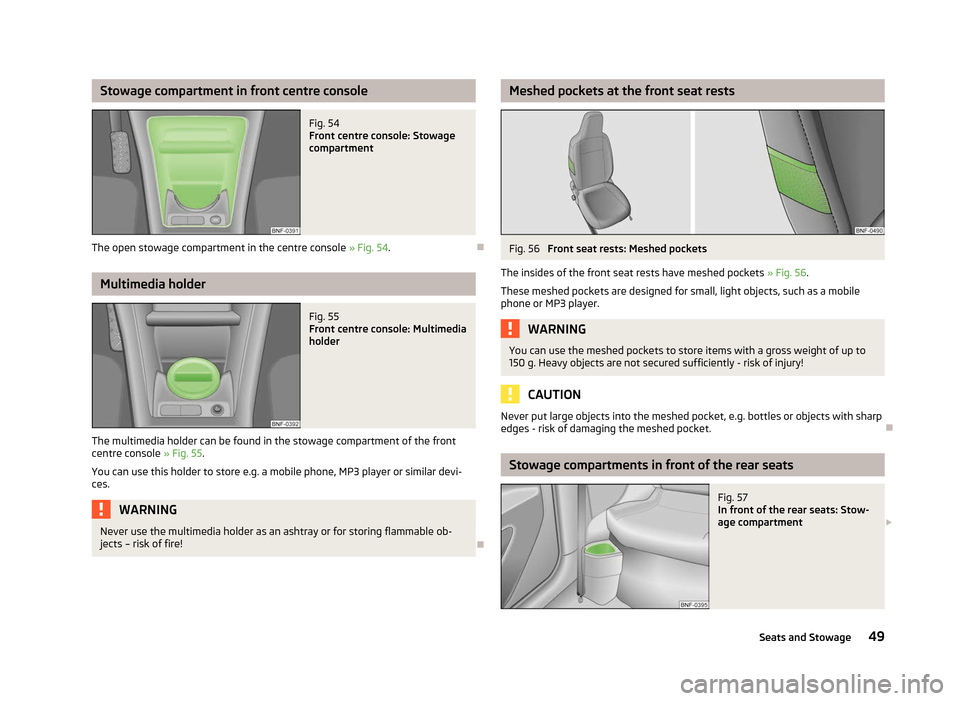
Stowage compartment in front centre console
Fig. 54
Front centre console: Stowage
compartment
The open stowage compartment in the centre console » Fig. 54. ÐMultimedia holder
Fig. 55
Front centre console: Multimedia
holder
The multimedia holder can be found in the stowage compartment of the front
centre console » Fig. 55.
You can use this holder to store e.g. a mobile phone, MP3 player or similar devi-
ces. WARNING
Never use the multimedia holder as an ashtray or for storing flammable ob-
jects – risk of fire! Ð Meshed pockets at the front seat rests
Fig. 56
Front seat rests: Meshed pockets
The insides of the front seat rests have meshed pockets » Fig. 56.
These meshed pockets are designed for small, light objects, such as a mobile
phone or MP3 player. WARNING
You can use the meshed pockets to store items with a gross weight of up to
150 g. Heavy objects are not secured sufficiently - risk of injury! CAUTION
Never put large objects into the meshed pocket, e.g. bottles or objects with sharp
edges - risk of damaging the meshed pocket. Ð Stowage compartments in front of the rear seats
Fig. 57
In front of the rear seats: Stow-
age compartment £
49
Seats and Stowage
Page 52 of 157
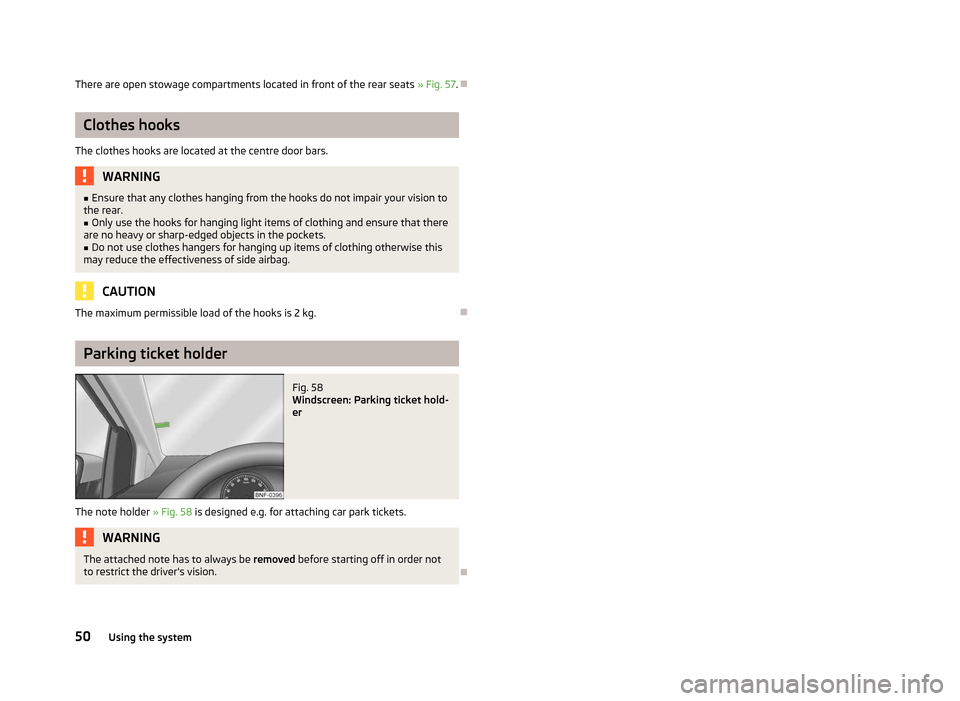
There are open stowage compartments located in front of the rear seats
» Fig. 57.ÐClothes hooks
The clothes hooks are located at the centre door bars. WARNING
■ Ensure that any clothes hanging from the hooks do not impair your vision to
the rear.
■ Only use the hooks for hanging light items of clothing and ensure that there
are no heavy or sharp-edged objects in the pockets.
■ Do not use clothes hangers for hanging up items of clothing otherwise this
may reduce the effectiveness of side airbag. CAUTION
The maximum permissible load of the hooks is 2 kg. ÐParking ticket holder
Fig. 58
Windscreen: Parking ticket hold-
er
The note holder » Fig. 58 is designed e.g. for attaching car park tickets.WARNING
The attached note has to always be removed before starting off in order not
to restrict the driver's vision. Ð50
Using the system
Page 76 of 157

Safety
Passive Safety
General information
ä
Introduction
This chapter contains information on the following subjects:
Safety equipment 74
Before setting off 74
What influences the driving safety? 75
In this section you will find important information, tips and notes on the subject
of passive safety in your vehicle. We have combined everything here which you
should be familiar with, for example, regarding seat belts, airbags, child seats and
safety of children. It is therefore important, in particular, to comply with the notes
and warnings in this section for your own interest and in the interest of those
travelling with you. WARNING
■ This chapter contains important information on how to use the vehicle for
the driver and his occupants. You will find further information on safety, which
concerns you and those travelling with you, in the following chapters of this
Owner's Manual.
■ The complete on-board literature should always be in the vehicle. This ap-
plies in particular, if you rent out or sell the vehicle. ÐSafety equipment
First read and observe the introductory information and safety warn-
ings on page 74.
The following list contains part of the safety equipment in your vehicle:
› three-point seat belts for all the seats;
› belt force limiters for the front seats;
ä ›
belt tensioners for front seats;
› Front airbag for the driver and the front seat passenger;
› Head-Thorax
- driver and front seat passenger side airbag with head restraint
function;
› anchoring points for child seat using the ISOFIX system;
› anchoring points for child seat using the TOP TETHER system;
› rear head restraints adjustable for height;
› steering column adjustable for height.
The specified safety equipment works together, in order to optimally protect you
and those travelling with you in accident situations. The safety equipment does
not protect you or the people travelling with you, if you or your occupants adopt
an incorrect seated position or the equipment is not correctly adjusted or used. Ð Before setting off
First read and observe the introductory information and safety warn-
ings on page 74.
For your own safety and the safety of the people travelling with you, please pay
attention to the following points before setting off.
›
Ensure that the lighting and the turn signal system are functioning properly.
› Check the tyre inflation pressure.
› Ensure that all of the windows offer good visibility to the outside.
› Secure all items of luggage
» page 41, Luggage compartment.
› Ensure that no objects can obstruct the pedals.
› Adjust the rear mirror and the front seat to your body size.
› Advise your passengers on the back seats to adjust the head restraints to their
body size.
› Protect children in suitable child seats with correctly fastened seat
belts
» page 87, Transporting children safely .
› Adopt the correct seated position
» page 75, Correct seated position . Tell your
passengers to assume the correct seated position.
› Correctly fasten the seat belt. Also inform passengers to fasten the seat belt
correctly » page 80 , Fastening and unfastening seat belts .Ð
ä
74 Safety
Page 77 of 157

What influences the driving safety?
First read and observe the introductory information and safety warn-
ings on page 74.
The driver is fully responsible for himself and his occupants. If your driving safety
is effected, you place yourself and the oncoming traffic at risk.
The following guidelines must therefore be observed. › Do not get distracted from concentrating on the traffic situation, e.g. by your
passengers or mobile phone calls.
› Never drive when your driving ability is impaired, e.g. through medication, alco-
hol, drugs.
› Keep to the traffic regulations and the permissible speed limit.
› Always adjust the driving speed to the road, traffic and weather conditions.
› Take regular breaks on long journeys – at least every two hours. ÐCorrect seated position
ä
Introduction
This chapter contains information on the following subjects:
Correct seated position for the driver 76
Correct seated position for the front passenger 76
Correct seated position for the occupants on the rear seats 76
Examples of an incorrect seated position 76
WARNING
■ The front seats and rear head restraints must always be adjusted to match
the body size, in order to offer an optimal protection for you and your occu-
pants.
■ Always assume the correct seated position before setting off and do not
change this position while driving. Also advise your passengers to adopt the
correct seated position and not to change this position while the car is mov-
ing.
■ If the occupant adopts an incorrect seated position, he is exposed to life-
threatening injuries, in case he is hit by a deployed airbag.
ä WARNING (Continued)
■ If the occupants on the rear seats are not sitting upright, the risk of injury is
increased due to incorrect routing of the seat belt.
■ The driver must maintain a distance of at least 25 cm to the steering wheel.
The front passenger must maintain a distance of at least 25 cm to the dash
panel. Not maintaining this minimum distance will mean that the airbag sys-
tem will not be able to properly protect you – hazard!
■ When driving, hold the steering wheel with both hands firmly on the outer
edge in the 9
o'clock and 3 o'clock position. Never hold the steering wheel in
the 12 o'clock position or in any other way (e.g. in the middle or inner edge of
the steering wheel). In such cases, you could severely injure the arms, hands
and head when the driver airbag is deployed.
■ The seat backrests must not be angled too far back when driving otherwise
this will affect proper operation of the seat belts and of the airbag system –
risk of injury!
■ Ensure that there are no objects in the driver's footwell as they may get
caught behind the pedals when driving or applying the braking. You would
then no longer be able to operate the clutch, brake or accelerate.
■ Always keep your feet in the footwell when the car is being driven – never
place your feet on the instrument panel, out of the window or on the surfaces
of the seats. You will be exposed to increased risk of injury if it becomes nec-
essary to apply the brake or in the event of an accident. If an airbag is de-
ployed, you may suffer fatal injuries when adopting an incorrect seated posi-
tion! Ð
75
Passive Safety
Page 78 of 157

Correct seated position for the driver
Fig. 78
The correct distance of the driv-
er to the steering wheel
First read and observe the introductory information and safety warn-
ings on page 75.
For your own safety and to reduce the risk of injury in the event of an accident,
we recommend the following setting.
› Adjust the steering wheel so that the distance A
» Fig. 78 between the steer-
ing wheel and your chest is at least 25
cm.
› Adjust the driver’s seat in the forward/back direction so that the pedals can be
fully depressed with slightly bent legs.
› Adjust the seat backrest so that the highest point of the steering wheel can be
reached with your arms at a slight angle.
› Correctly fasten the seat belt
» page 80.
Driver seat adjustment » page 38, Adjusting the front seats .ÐCorrect seated position for the front passenger
First read and observe the introductory information and safety warn-
ings on page 75.
For the safety of the front passenger and to reduce the risk of injury in the event
of an accident, we recommend the following setting.
› Position the front passenger seat back as far as possible. The front passenger
must maintain a distance of at least 25 cm to the dash panel so that the airbag
offers the greatest possible safety if it is deployed.
› Correctly fasten the seat belt
» page 80.
In exceptional cases the front passenger airbag can be deactivated »
page 85,
Switching off the airbags .
ä
ä Front passenger adjustment
» page 38, Adjusting the front seats .Ð Correct seated position for the occupants on the rear seats
First read and observe the introductory information and safety warn-
ings on page 75.
To reduce the risk of injury in the event of a sudden braking manoeuvre or an ac-
cident, the occupants on the rear seats must observe the following.
› Adjust the head restraint so that the top edge of the head restraint is at the
same level as the upper part of your head.
› Correctly fasten the seat belt
» page 80.
› Use a suitable child restraint system if transporting children in the vehi-
cle
» page 87, Transporting children safely .Ð Examples of an incorrect seated position
First read and observe the introductory information and safety warn-
ings on page 75.
Seat belts offer their optimum protection only if the webbing of the seat belts is
properly routed. Incorrect seated positions considerably reduce the protective
functions of the seat belts and therefore increase the risk of injury due to an in-
correct routing of the seat belt. The driver is fully responsible for himself and pas-
sengers, especially children. Never allow a passenger to adopt an incorrect seated
position when the car is moving.
The following list contains examples of which seated positions can cause serious
injuries or death. This list is not complete, however we would like you to familiar-
ise yourself with this subject.
Therefore, while the car is moving never:
› stand up in the vehicle;
› stand up on the seats;
› kneel on the seats;
› tilt the seat backrest fully to the back;
› lean against the dash panel;
› lie on the rear seat bench;
› only sit on the front area of the seat;
› sit to the side;
› lean out of the window;
£
ä
ä
76 Safety